
The Dublin Area Rapid Transit system is an electrified commuter rail railway network serving the coastline and city of Dublin, Ireland. The service makes up the core of Dublin's suburban railway network, stretching from Greystones, County Wicklow, in the south to Howth and Malahide in north County Dublin. The DART serves 31 stations and consists of 53 route kilometres of electrified railway, and carries in the region of 20 million passengers per year. In a similar manner to the Berlin S-Bahn, the DART blends elements of a commuter rail service and a rapid transit system.

Rail transport in Ireland is provided by Iarnród Éireann in the Republic of Ireland and by Northern Ireland Railways in Northern Ireland.

Connolly station or Dublin Connolly is one of the busiest railway stations in Dublin and Ireland, and is a focal point in the Irish route network. On the North side of the River Liffey, it provides InterCity, Enterprise and commuter services to the north, north-west, south-east and south-west. The north–south Dublin Area Rapid Transit (DART) and Luas red line light rail services also pass through the station. The station offices are the headquarters of Irish Rail, Iarnród Éireann. Opened in 1844 as Dublin Station, the ornate facade has a distinctive Italianate tower at its centre.

Heuston Station, also known as Dublin Heuston, is one of Dublin's largest railway stations and links the capital with the south, southwest and west of Ireland. It is operated by Iarnród Éireann (IÉ), the national railway operator. It also houses the head office of its parent company, Córas Iompair Éireann (CIÉ). The station is named in honour of Seán Heuston, an executed leader of the 1916 Easter Rising, who had worked in the station's offices.

Spencer Dock is a former wharf area, close to where the Royal Canal meets the River Liffey, in the North Wall area of Dublin, Ireland. As of the 21st century, the area has been redeveloped with occupants of the Spencer Dock development including the Convention Centre Dublin, PricewaterhouseCoopers' Irish headquarters, Credit Suisse and TMF Group. The Central Bank of Ireland and NTMA have offices in the nearby Dublin Landings development.
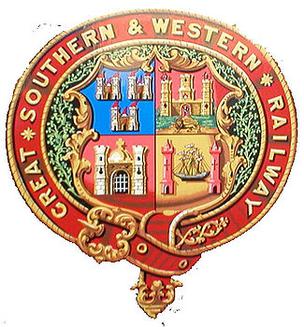
The Great Southern and Western Railway (GS&WR) was an Irish gauge railway company in Ireland from 1844 until 1924. The GS&WR grew by building lines and making a series of takeovers, until in the late 19th and early 20th centuries it was the largest of Ireland's "Big Four" railway networks. At its peak the GS&WR had an 1,100-mile (1,800 km) network, of which 240 miles (390 km) were double track.

The Midland Great Western Railway (MGWR) was the third largest Irish gauge railway company in Ireland. It was incorporated in 1845 and absorbed into the Great Southern Railways in 1924. At its peak the MGWR had a network of 538 miles (866 km), making it Ireland's third largest network after the Great Southern and Western Railway (GS&WR) and the Great Northern Railway of Ireland.

Transport 21 was an Irish infrastructure plan, announced in November 2005. Its aims were to greatly expand Ireland's transport network. A cost estimate of €34 billion was attached to the plan at the time.
DART Underground, also known as the Interconnector or DART+ Tunnel, is a proposed mainline-rail tunnel in Dublin, Ireland. First proposed in 1972, as of 2021 it was not funded or scheduled. While the Greater Dublin Transport Strategy 2016-2035 included the DART Underground as a proposed National Transport Authority project, the tunnel was not included in the National Development Plan published in 2018 or DART+ expansion plans published in August 2020.
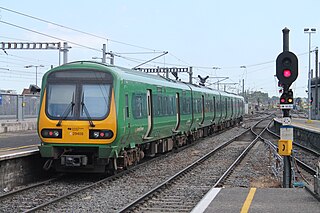
The Dublin Suburban Rail network, branded as Commuter, is a railway network that serves the city of Dublin, Ireland, most of the Greater Dublin Area and outlying towns. The system is made up of five lines:

Athlone railway station is a station which serves the town of Athlone in County Roscommon and County Westmeath. It is located in the town on the east side of the river Shannon.

Westport railway station serves the town of Westport, County Mayo, Ireland.

Commuter is a brand of suburban rail services operated by Iarnród Éireann in the Republic of Ireland, serving the cities of Dublin, Cork, Limerick and Galway. This brand is distinct from the longer distance InterCity brand, and Dublin's higher frequency DART brand. Most Commuter services share a track with InterCity services. During the first decade of the new millennium, Iarnród Éireann put a significant amount of effort into upgrading its network, with new tracks, signalling, station upgrades and trains. Commuter services are operated by diesel multiple unit train sets.
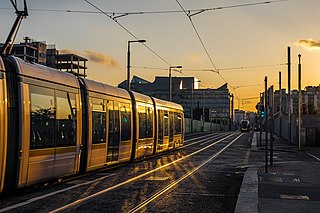
This article deals with transport in the Greater Dublin Area centred on the city of Dublin in Ireland.

The Dublin–Cork Main Line is the main InterCity railway route in Ireland between Dublin Heuston and Cork Kent. In 2018, 3.46 million passengers travelled on the line, a 10% increase from 2017 figures.

Broadstone railway station was the Dublin terminus of the Midland Great Western Railway (MGWR), located in the Dublin suburb of Broadstone. The site also contained the MGWR railway works and a steam locomotive motive power depot. A Luas tram station opened at the front of the station in 2017.
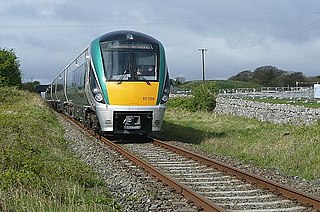
The Dublin-Westport/Galway line is a major railway route from Dublin to Galway or Westport, County Mayo. The line is part of the greater intercity rail network formed by branches of the main line between Dublin and Cork. The route to Westport and Galway branches away from the main line at Portarlington in County Laois and continues as far as Athlone in County Westmeath, where it splits again, with one branch to Westport and the other to Galway.
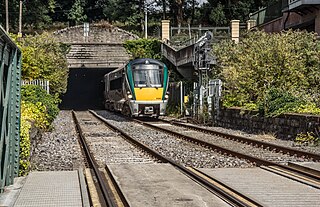
The Phoenix Park Tunnel is a railway tunnel in Dublin, Ireland. The tunnel was built in 1877 and begins at the Liffey Railway Bridge near Heuston Station, running underneath the Phoenix Park for 757 yards (692 m) before re-emerging close to the junction of the Infirmary Road and North Circular Road. It joins with the Sligo line near Glasnevin, before continuing to Dublin Connolly.

North Wall was one of Dublin's six original rail termini, the others being Westland Row, Amiens Street, Kingsbridge, Broadstone and Harcourt Street.


















